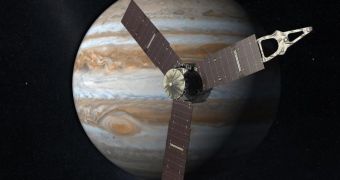On August 5, 2011, at 16:25 UTC, NASA launched a New Frontiers mission called Juno, from the Cape Canaveral Air Force Station (CCAFS). Destined to analyze Jupiter, the spacecraft is currently far away from Earth. Scientists have recently conducted a series of tests using its video camera.
The purpose of these assessments was to figure out whether the instrument was working properly. The mission is managed by experts at the NASA Jet Propulsion Laboratory (JPL), in Pasadena, California.
Built by main contractor Lockheed Martin, the spacecraft will complete about 33 orbits around Jupiter, when it reaches the gas giant, in August 2016. This planet is the largest in the solar system, but experts know less about it than they know about its neighbor, Saturn.
Juno launched aboard an Atlas V delivery system from the Space Launch Complex 41 (SLC-41). It will spend around 5 years cruising towards its target, and a year conducting actual science. It features a suite of 9 scientific instruments for this purpose.
These are the Microwave radiometer, Jovian Infrared Auroral Mapper, Advanced Stellar Compass, Flux Gate Magnetometer (FGM), Jovian Auroral Distribution Experiment, Jovian Energetic Particle Detector Instrument, Radio and Plasma Wave Sensor, Ultraviolet Imaging Spectrograph, and JunoCam.
In order to make sure that JunoCam is operational, JPL experts have recently had it image the Big Dipper, arguably the most famous constellation in the night sky. The spacecraft is currently around 380 million miles (612 million kilometers) away from Earth, and some 280 days into its journey.
“I can recall as a kid making an imaginary line from the two stars that make up the right side of the Big Dipper's bowl and extending it upward to find the North Star. Now, the Big Dipper is helping me make sure the camera aboard Juno is ready to do its job,” Scott Bolton explains.
The expert holds an appointment as the principal investigator of Juno mission. He is based at the Southwest Research Institute (SwRI), in San Antonio. “I don't know if it's the first space-based image of the Big Dipper but, as it was taken when we were well beyond Mars orbit, it's probably from the farthest out,” he adds.
“But much more important than that is the simple fact that JunoCam, like the rest of this mission, works as advertised and is ready for its day in the Sun – around Jupiter,” Bolton concludes.

 14 DAY TRIAL //
14 DAY TRIAL // 
